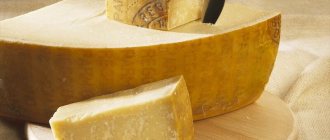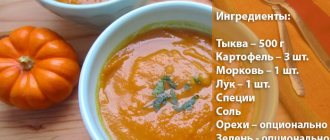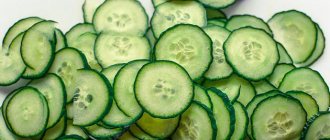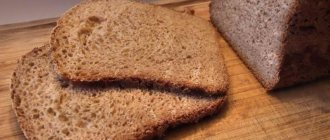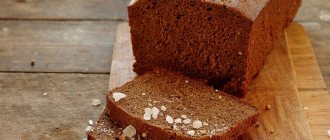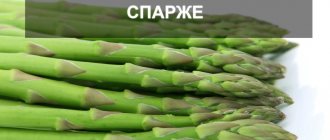Asparagus protects against dangerous diseases, reduces blood pressure and increases stress resistance. Find out the calorie content of white, green and purple asparagus, and include dishes from it in your daily menu!
Author: Kristina Lobanovskaya, doctor, practicing nutritionist Article updated: 11/09/2020
Ask a Question
Asparagus is a herb or shrub with thin scaly leaves, known to mankind for more than 2000 years. The young shoots that grow underground or the tops of the shoots of some species of asparagus (the plant's scientific name) are used as food. The calorie content of asparagus is on average 22 kcal per 100 grams, which, coupled with its neutral taste and excellent compatibility with aromatic foods, makes it a very popular component of any, especially dietary, diet. In addition, there is another “asparagus” on the Russian grocery market, which has nothing to do with the specified plant, but is a soybean semi-finished product and is a very common dish in some Asian cuisines. At the same time, the calorie content of soybean asparagus is on average 337 kcal/100 g, which is 15 times higher than that of real asparagus sprouts.
How many calories are in asparagus
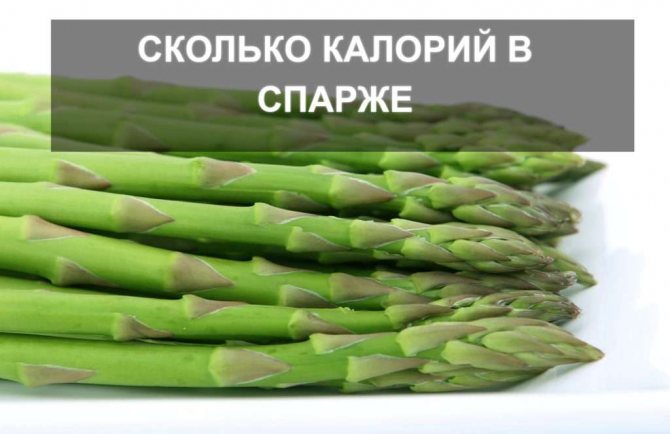
Asparagus has only 39 calories per 100 grams. Depending on how it was prepared. In any case, asparagus can be classified as a low-calorie product.
Asparagus is very rich in vitamins and microelements, so during diets, any nutritionist will include it in your daily diet.
Asparagus during your diet will provide your body with all the necessary vitamins and microelements.
Dishes
Asparagus stems and semi-finished soybeans are actively used in cooking. Both products are components of many dishes - they are boiled, pickled, added to soups and prepared as a separate appetizer. But the caloric content of asparagus - real and made from soy - and the principles of preparing each of them are completely different.
From asparagus shoots
Asparagus sprouts are eaten fresh or processed in any way - they can be boiled in water or steamed, fried, grilled, or pickled. Asparagus is an excellent independent snack and an excellent side dish for meat or fish, since it significantly reduces calorie content and increases the beneficial properties of such dishes.
Boiled
The easiest way to prepare asparagus stems is boiling, which does not require special culinary skills or the addition of expensive ingredients. Place the shoots in a colander, lower them into salted boiling water, and cook for 4 minutes. Ready-made boiled asparagus has a mild, delicate taste and the same low calorie content as fresh sprouts - on average 22 kcal/100 g. To get a more interesting and not bland product, albeit with an increased calorie content, it is recommended to use the sprouts with creamy sauce.
Stewed
The preparation of stewed asparagus is also simple and accessible, and the dish itself has a variety of beneficial properties for humans. To do this, finely chop 100 g of onion and 100 g of carrots in random order. Place in a deep frying pan, place on low heat and simmer until half cooked. Add 300 g of asparagus shoots cut into pieces and 2 tbsp. l. tomato sauce. Simmer until done. The calorie content of asparagus in this recipe is 31.5 kcal/100 g.
To improve the taste, you can add vegetable oil or butter. But it should be borne in mind that these products (especially the second one) have high energy value, so the total calorie content of the dish can increase several times.
Grilled
Whole asparagus shoots are mixed with a little olive oil, salt and pepper. Place on grill grate and cook for 3-5 minutes. Then transfer the crispy sticks with a soft center to a plate and sprinkle with lemon zest and grated cheese to improve the taste. The calorie content of asparagus baked in this way is 30 kcal/100 g. The total calorie content of the dish depends on the type, fat content and amount of cheese used.
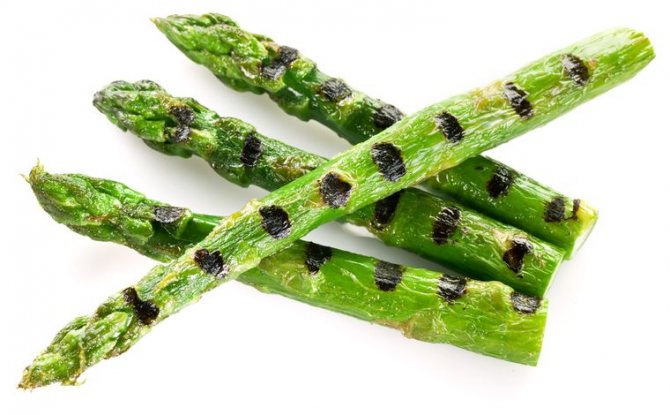
From soy asparagus
For use in cooking, dry semi-finished soybean products are best suited, from which you can prepare a variety of dishes. Before cooking, the plates are soaked in water in one of two ways: soaked for a day in cold water or steamed with boiling water for 1–2 hours. After this, they become ready for further use. Thanks to their neutral taste, they are considered an ideal base or simply a useful component for any dish.
Korean salad
A classic salad made from a concentrated soy product has a fairly high calorie content - 245 kcal/100 g, mainly due to the increase in the amount of sugars contained in carrots and other ingredients. To prepare the dish, 150 g of dry soybean concentrate is soaked in water, then the excess moisture is squeezed out and cut into pieces 4–5 cm long. Add 10 ml of vinegar, 40 ml of soy sauce, 20 g of sugar, 2 chopped garlic cloves, a little sesame and coriander.
Separately, fry 2 onions, cut into rings, in a small amount of vegetable oil and grate 2 carrots on a special grater to make long shavings, as when preparing carrots in Korean. Place grated carrots in a deep dish first, asparagus pieces on top, then fried onions. Mix everything carefully and leave to infuse for 30 minutes, after which it is consumed as an independent snack or a side dish for meat and fish.
soup
A lean, hearty, healthy and easy-to-prepare soup is made from soy concentrate with the addition of carrots, coriander and garlic. The use of these seasonings gives the dish the aroma of the well-known Korean carrots, and its taste is reminiscent of a traditional winter soup cooked in broth with noodles and carrots. The calorie content of such a dish is 223 kcal/100 g.

The soup is prepared from 60 g of dry product, which is soaked in water and then used as a base, instead of broth. The semi-finished product, saturated with moisture, is cut into small pieces. Separately, grate 1 carrot and chop 4-5 cloves of garlic in a convenient way, and then fry these vegetables in 1 tbsp. l. olive oil, stirring constantly.
Add chopped soy cubes and carrot-garlic dressing to boiling water, add a little coriander to taste. Bring to a boil, add a little salt, and cook over low heat for 4–5 minutes. The soup is served hot.
Pickled
Pickled fuju is a traditional Asian dish. With this cooking method, the calorie content of Korean asparagus is reduced to an average of 330 kcal/100 g.
A pre-soaked dry product weighing 250 g is squeezed out, boiled, cooled and cut into random order. Prepare the marinade separately by mixing 5 tbsp. l. olive or sunflower oil with 1 tbsp. l. balsamic vinegar, 2 tbsp. l. soy sauce, garlic, pepper, salt and sugar to taste. Fuzhu plates are poured with dressing in a deep container, covered with cling film on top and left in the refrigerator to marinate for several hours or overnight.
Harm of asparagus
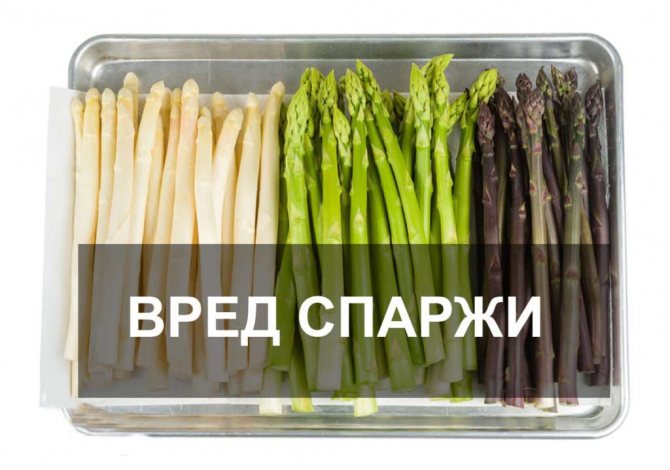
Despite all the positive qualities of this product, asparagus also has negative qualities, like any product. As they say, everything should be in moderation without going overboard.
Asparagus can in rare cases cause allergies. It is also not recommended to use this product if you have a stomach ulcer. Men and women are not recommended to eat asparagus if they have prostatitis and cystitis, respectively.
Beneficial features
Asparagus is valued for its high amount of dietary fiber. They are necessary for the body to function properly in the intestines.
Asparagus has the following beneficial properties:
| Impact on the body | Description | |
| Prevents anemia | The plant contains a lot of iron. This element can increase the level of hemoglobin in the blood and prevent the development of anemia | |
| Copes with atherosclerosis | Due to the high content of nicotinic acid, the plant helps cleanse blood vessels and prevent the formation of cholesterol plaques | |
| Prevents varicose veins | By consuming asparagus daily, you can prevent and stop the development of varicose veins. The product helps strengthen veins and capillaries | |
| Lowers blood pressure | Asparagus is good for people suffering from hypertension. The plant effectively thins the blood, relieves muscle spasms and lowers blood pressure. | |
| Strengthens the nervous system | B vitamins and vitamin PP, which are found in large quantities in asparagus, have a beneficial effect on the central nervous system. If a person regularly uses this product, it will become easier for him to cope with stress, he will be able to avoid depression and get rid of insomnia. For women during the premenstrual period, asparagus will help recharge their batteries and stay in a good mood. | |
| Improves vision | The product contains a lot of retinol. The action of this element is aimed at strengthening the retina, the condition of which affects visual acuity. With daily use, you can avoid the appearance of cataracts and glaucoma. | |
| Cleanses the lungs | Doctors recommend using the product for respiratory diseases. The plant contains organic compounds (saponins), which promote better removal of mucus from the bronchi. | |
| Strengthens the immune system | The product contains a lot of beta-carotene, vitamins C and A. These elements increase the body's immunity. This is especially true in winter and spring. | |
Asparagus is on the list of foods recommended for people with diabetes. It is low in carbohydrates, so blood sugar levels do not rise.
Asparagus will be appreciated by people who want to lose extra pounds. Due to the low calorie content of the product and the large amount of coarse fibers, metabolic processes are accelerated, which leads to increased breakdown of fat tissue. Thanks to this, after losing weight, a person will not be prone to sudden weight gain, even if he stops eating asparagus.
The product benefits men's health. It contains the valuable amino acid asparagine. It normalizes the activity of the prostate gland and protects against the occurrence of prostatitis. Asparagus shoots are recommended for use by men after 40 years of age, as they increase potency and sexual desire.
Asparagus is good for women during pregnancy. It contains a lot of folic acid. This element is necessary for the proper intrauterine development of the fetus, and it is also involved in cell division and growth of the embryo.
But excessive consumption of the plant during pregnancy can provoke an allergic reaction, including the appearance of hives.
Recipes
Chicken salad
Salad with chicken fillet and green asparagus. The total calorie content of the dish is 260 kcal.
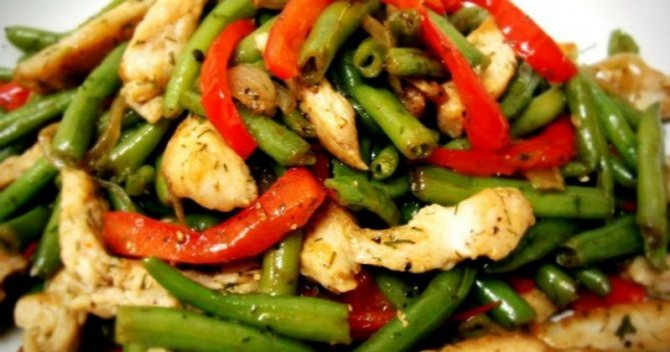
Asparagus should be cut into pieces about 2 centimeters long and boiled in boiling salted water with added sugar for 3-4 minutes. Also cut the chicken fillet into pieces and fry without adding oil until cooked. In a separate container, mix cottage cheese, yogurt and lemon zest. After the finished asparagus and fillets have cooled, add chopped lettuce leaves and season with sauce.
Warm salad
Warm salad with asparagus and spicy cherry tomatoes. The calorie content of the dish is no more than 70 kcal. Ideal addition to the menu for those losing weight.
Asparagus stalks are boiled whole in boiling salted water. The egg needs to be soft-boiled or poached. Finely chop all the onions and garlic, cut the tomatoes into 4 parts each and fry in a saucepan with added oil in the following order:
- First, fry regular onions and add a pinch of coriander and pepper to it (you can also add Provençal herbs);
- Once the onion begins to turn slightly golden, add cherry tomatoes and simmer for another minute;
- Add wine vinegar and green onions with garlic and fry for a couple more minutes.
Place the prepared stems on a dish, followed by the dressing with spicy cherry tomatoes and then put in a boiled egg, which needs to be cut so that the yolk drips beautifully.
THESE ARTICLES WILL HELP YOU LOSE WEIGHT
Your feedback on the article:
(561 ratings, average: 4.54 out of 5)
Unique product
Soy asparagus, also known as fuju or yuca, is a semi-finished soybean product that the Chinese prepare as a national dish.
The main ingredient used in Korean asparagus recipes is not directly related to the plant of the same name. It is correct to call it yuca in Japanese, fuzhu in Chinese, or at least Chinese fern.
How to make asparagus in Korean if this plant is not its basis? The product is prepared from soy milk, which is boiled until a film appears on its surface - fupi. If you hang this film, it takes on an interesting elongated shape. When it dries, it becomes fuzhu.
You may be wondering what exactly is soy milk? In fact, it is ordinary soybean, crushed until smooth and then boiled.
Milk is prepared very simply:
The smell of such milk is quite pleasant, the color is natural, but it has no taste as such.
Another thing is the Chinese fern. Its taste is original and piquant, so having Korean asparagus salad on the table will be the highlight of your dinner party. In addition, as nutritionists note, thanks to fuzhu you can improve your health and lose excess weight.
Contraindications
Uncontrolled consumption of asparagus in Korean will harm the body. Soy products cause problems with the formation of the reproductive system, so they should not be given to children. Korean asparagus is contraindicated in women at risk for developing estrogen-sensitive tumors.

Soy oxalates tend to accumulate in the kidneys, so the product should not be eaten by people with kidney problems. It is used with caution in the following cases:
- gastrointestinal diseases (in acute stages);
- cystitis;
- prostatitis.
Please note that soy products can cause severe allergic reactions. To prevent the development of undesirable effects, it is enough to use it no more than once every 2 weeks.
